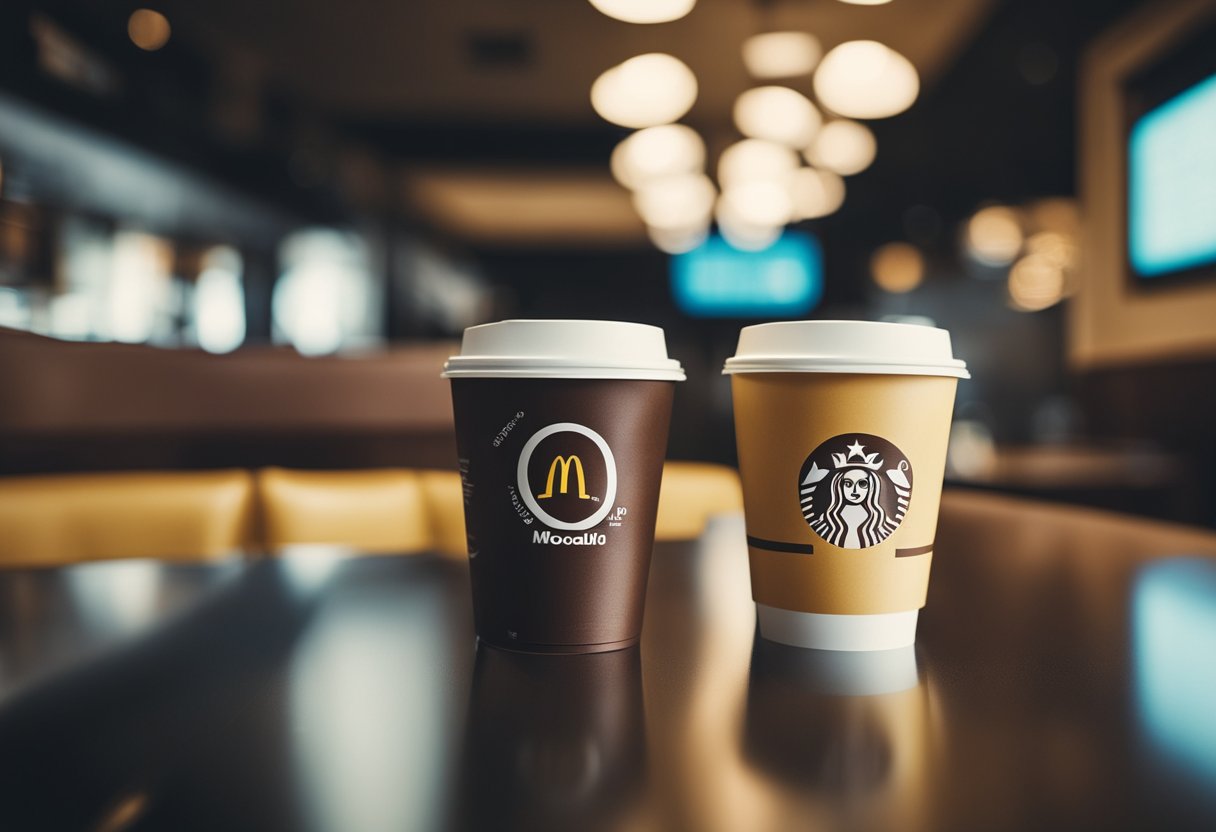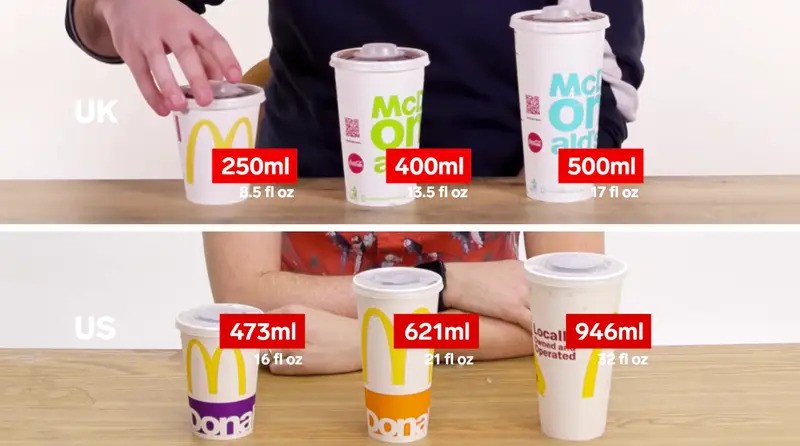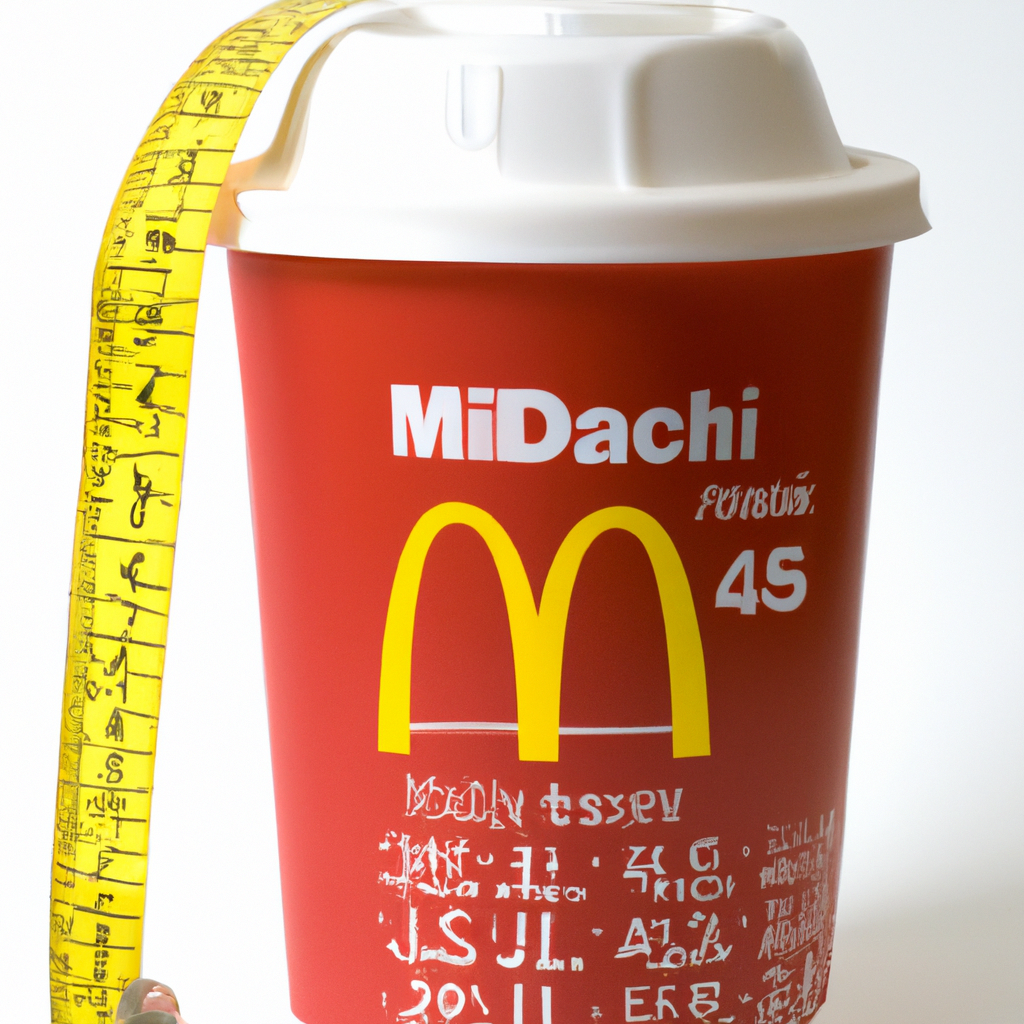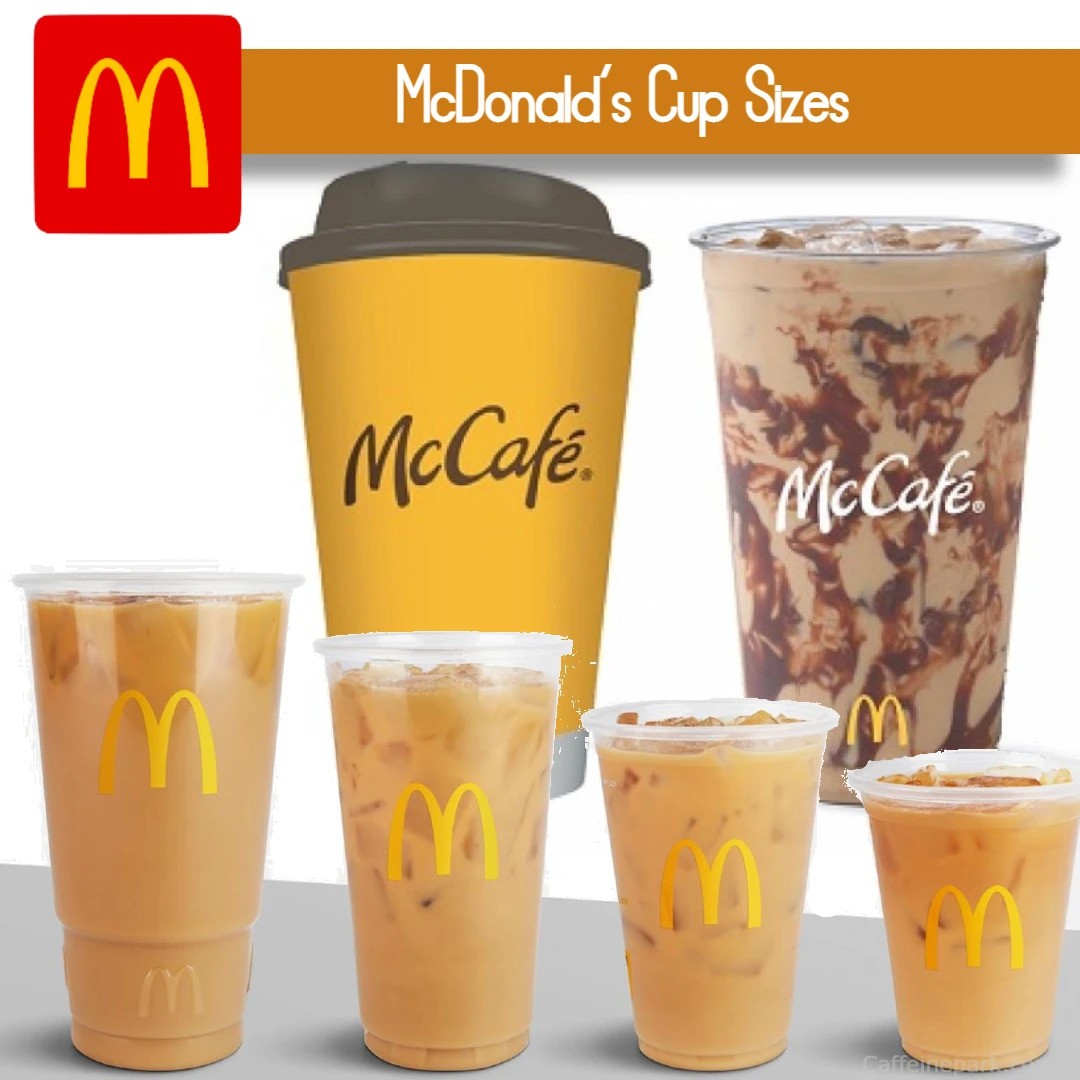
McDonald’s coffee cups come in various sizes, but how do they compare worldwide? Do they offer the same experience everywhere?
As one of the largest fast-food chains, McDonald’s serves millions of coffee lovers daily. Its coffee cup sizes vary across regions, impacting customer preferences and sustainability efforts.
In this post, we’ll explore McDonald’s coffee cup sizes, their global variations, and how they compare with other brands. You’ll also learn about nutritional aspects, refill policies, and future trends in sustainable packaging.
Understanding McDonald's Coffee Cup Sizes
McDonald's has made significant efforts to standardize their coffee cup sizes globally, providing customers with consistent options across their thousands of locations. However, subtle variations still exist between different countries and regions.
Standard Coffee Cup Sizes at McDonald's
McDonald's offers four primary coffee cup sizes in most locations. In 2021, the company initiated a standardization process to ensure more consistent sizing across their global operations.
| Size | Volume (US) | Volume (Metric) |
| Small | 12 oz | 354 ml |
| Medium | 18 oz | 532 ml |
| Large | 21 oz | 621 ml |
| Extra Large | 32 oz | 946 ml |
Each size is designed to cater to different customer needs. The small cup is perfect for a quick caffeine boost, while the large and extra-large options are ideal for those who prefer to enjoy their coffee over an extended period or need a substantial caffeine kick to start their day.

Size Variations in Different Locations and Countries
Despite McDonald's efforts to standardize cup sizes worldwide, variations still exist across different regions:
United States: Follows the standard sizing (Small: 12 oz, Medium: 18 oz, Large: 21 oz, Extra Large: 32 oz)
Canada: Similar to US sizing but may have slight regional variations
United Kingdom/Europe: Typically uses metric measurements and smaller sizes
Australia: Uses standard sizes but may label them differently in some locations
It's worth noting that some locations may not offer all size options, particularly the Extra Large size which is less common in European markets due to different consumer preferences and health guidelines.
Comparison with Other Coffee Chains
When comparing McDonald's coffee cup sizes with other major coffee chains, there are noticeable differences in both size and terminology:
McDonald's vs. Competitors Cup Size Comparison
McDonald's Large (21 oz/621 ml) is slightly larger than:
McDonald's Medium (18 oz/532 ml) is larger than:
Other Notable Comparisons:
Dunkin' Donuts: Small (10 oz), Medium (14 oz), Large (20 oz)
Costa Coffee: Small (8 oz), Medium (12 oz), Large (16 oz)
Dutch Bros Coffee: Small (12 oz), Medium (16 oz), Large (24 oz)
These variations highlight how McDonald's positions itself in the competitive coffee market—offering slightly more volume than many specialty coffee shops at a lower price point.
Impact of Cup Size on Coffee Taste Perception
The size of a coffee cup can significantly influence how customers perceive the taste of their coffee through several mechanisms:
"It is important to note that the size of the coffee cup can affect how a person perceives the taste of their coffee. Therefore, it is essential to choose the right size that suits one's taste buds."
Larger cups:
Allow more aroma to accumulate, enhancing the sensory experience
May cool faster due to increased surface area
Can dilute the coffee experience if filled with too much ice or milk
Create an expectation of value but may lead to consuming more than intended
Smaller cups:
Concentrate flavors and aromas in a smaller space
Maintain temperature longer
Create a perception of stronger, more intense flavor
May be associated with higher quality in specialty coffee contexts
This psychological aspect of cup sizing plays an important role in McDonald's marketing strategy, balancing perceived value with actual consumption experience.

Detailed Breakdown of Coffee Sizes
McDonald's offers four primary coffee cup sizes, each catering to different preferences and caffeine needs. Whether you're looking for a quick pick-me-up or a large coffee to last throughout the day, McDonald's provides options to suit every coffee drinker.
Small Coffee (12 oz) – A Quick Caffeine Boost
For those who need a light dose of caffeine without overconsumption, the small coffee is an excellent choice.
Size: 12 ounces (354 ml)
Best for: A quick morning boost or a small, satisfying drink
Caffeine content: Approximately 109 mg (varies by brewing method)
Pros:
Ideal for those sensitive to caffeine
Retains heat well due to its compact size
Lower calorie count when additives are included
Cons:
Medium Coffee (18 oz) – Balanced Quantity and Caffeine
A great middle-ground option, the medium coffee balances volume and caffeine intake without feeling excessive.
Large Coffee (21 oz) – Ideal for Extended Consumption
The large coffee is designed for those who prefer sipping their coffee over a longer period.
Extra Large Coffee (32 oz) – Maximum Caffeine Intake
For those who require maximum caffeine, the extra-large coffee is the biggest size available at select McDonald's locations.
Comparison Table: McDonald's Coffee Sizes
| Size | Ounces | Milliliters | Caffeine Content (Approx.) | Best For |
| Small | 12 oz | 354 ml | 109 mg | Quick boost |
| Medium | 18 oz | 532 ml | 145 mg | Balanced intake |
| Large | 21 oz | 621 ml | 185 mg | Long-lasting enjoyment |
| Extra Large | 32 oz | 946 ml | 250 mg | Maximum caffeine |
Key Takeaways
Small coffee is ideal for those needing a light caffeine boost.
Medium coffee offers a balance between quantity and caffeine.
Large coffee is suitable for those who want to sip their coffee longer.
Extra-large coffee provides the highest caffeine intake but isn’t available everywhere.
Nutritional Information
Understanding the nutritional profile of McDonald's coffee offerings is essential for health-conscious consumers. This section provides a comprehensive breakdown of calories, caffeine content, and other important dietary considerations.
Caloric Content: Black Coffee vs. Coffee with Additives
McDonald's black coffee is remarkably low in calories, making it an excellent choice for those monitoring their caloric intake.
| Coffee Type | Small (12 oz) | Medium (18 oz) | Large (21 oz) | Extra Large (32 oz) |
| Black Coffee | 0 calories | 0 calories | 0 calories | 0 calories |
| With Cream | +30 calories | +45 calories | +50 calories | +80 calories |
| With Sugar (1 packet) | +15 calories | +15 calories | +15 calories | +15 calories |
| With Cream & Sugar | +45 calories | +60 calories | +65 calories | +95 calories |
Key Insight: While black coffee contains virtually no calories, additions like cream and sugar can transform your coffee into a significant source of empty calories. A premium coffee with flavored syrup, whipped cream, and whole milk can contain upwards of 200-400 calories.
Caffeine Content: How Different Sizes Compare
Caffeine content naturally increases with cup size, but the concentration remains consistent across all options.
Small (12 oz): Approximately 115mg of caffeine
Medium (18 oz): Approximately 170mg of caffeine
Large (21 oz): Approximately 200mg of caffeine
Extra Large (32 oz): Approximately 305mg of caffeine
These values represent McDonald's standard premium roast coffee. Specialty McCafé drinks may contain varying amounts of caffeine depending on the number of espresso shots used.
Health Considerations: Recommended Daily Caffeine Intake
Medical experts and health organizations provide clear guidelines on caffeine consumption:
Recommended daily limit: Adults should consume no more than 400mg of caffeine per day
Moderation is key: A large McDonald's coffee (200mg) represents roughly half the daily recommended limit
Individual sensitivity varies: Some people may experience adverse effects at lower levels
Special populations: Pregnant women, those with certain medical conditions, and children should further limit caffeine intake
Effects of excessive caffeine consumption include:
Dietary Concerns: Allergen Information and Ingredient Transparency
McDonald's provides comprehensive allergen information for customers with dietary restrictions:
Major allergens tracked: McDonald's tracks the nine most common allergens (eggs, dairy, wheat, soy, peanuts, tree nuts, fish, shellfish, and sesame)
Cross-contamination risk: Due to shared preparation areas and equipment, McDonald's cannot guarantee that any product is completely allergen-free
Ingredient transparency: Detailed ingredient lists are available upon request and on their website
Special dietary needs: McDonald's does not specifically market any items as vegetarian, vegan, or gluten-free

Exploring the McCafé Menu
The McCafé menu has transformed McDonald's from a simple coffee provider into a legitimate competitor in the specialty coffee market. Since its introduction, McCafé has expanded to offer a diverse range of coffee and espresso-based beverages crafted with 100% Arabica beans, catering to various consumer preferences.
Espresso-Based Drinks
McDonald's McCafé menu features several classic espresso-based beverages that rival those found in dedicated coffee shops:
Latte: Smooth and creamy, made with freshly brewed espresso and steamed milk, available in various sizes
Cappuccino: A perfect balance of espresso, steamed milk, and frothed milk creating a velvety texture
Americano: Bold and robust flavor profile, combining espresso with hot water for coffee enthusiasts who prefer stronger taste
Macchiato: Layered espresso marked with a small amount of milk, offering an elegant presentation and balanced flavor
"Each McCafé espresso drink is made with freshly brewed espresso and steamed milk, creating a smooth and creamy texture." - From the official menu description
Specialty Drinks
Beyond the traditional offerings, McCafé provides signature specialty beverages that have become customer favorites:
| Specialty Drink | Description | Available Formats |
| Caramel Macchiato | Layered espresso with vanilla, milk, and caramel drizzle | Hot, Iced |
| Mocha | Rich chocolate flavor combined with espresso and topped with whipped cream | Hot, Iced |
| Frappé | Blended ice beverage with coffee, available in various flavors | Caramel, Mocha, Chocolate Chip |
| Iced Coffee | Cold-brewed coffee served over ice with optional flavor additions | Regular, Flavored |
These specialty drinks offer seasonal variations throughout the year, with limited-time offerings that keep the menu fresh and exciting for regular customers.
Customization Options
McDonald's understands that personalization is key to customer satisfaction, providing multiple ways to customize McCafé beverages:
Milk Options:
Whole Milk (standard)
Reduced-Fat Milk
Nonfat Milk
Cream
Flavor Syrups:
Vanilla
Caramel
Hazelnut
Sugar-Free Vanilla
Sweetness Adjustments:
Standard sweetness
Extra sweet
Light sweetness
Unsweetened
Customers can also request additional customizations such as extra espresso shots, light ice for cold beverages, or whipped cream additions/removals to suit their preferences.
McDonald's Commitment to Quality Coffee
McDonald's has made significant investments to ensure their coffee meets high-quality standards:
100% Arabica Beans: All McCafé coffee beverages use premium Arabica beans, known for their superior flavor profile and complex taste notes compared to Robusta varieties
Ethical Sourcing: Partnership with suppliers to ensure beans are responsibly grown and harvested
Rainforest Alliance Certification: Many of McDonald's coffee beans come from certified farms that meet environmental and social standards
Quality Control: Strict procedures ensure coffee freshness and consistent taste across all locations
Brewing Process: Freshly ground beans and precise brewing methods deliver optimal flavor extraction
McDonald's Cup Sizes in the Broader Fast-Food Industry
McDonald's cup sizing strategy represents a fascinating microcosm of larger industry trends. As one of the world's most influential fast-food chains, McDonald's has both responded to and shaped consumer expectations regarding beverage portions, while implementing standardization practices that impact the entire quick-service restaurant sector.
Evolution of Fast-Food Drink Sizes
The journey of fast-food beverage sizing reflects changing American consumption patterns and marketing approaches:
Historical Progression of Fast-Food Cup Sizes:
| Era | Typical "Large" Size | Industry Trend |
| 1950s-1960s | 12-16 oz | Conservative portions, coffee as secondary offering |
| 1970s-1980s | 16-22 oz | Growing portion sizes, increased focus on beverages |
| 1990s-Early 2000s | 32-44 oz | "Supersize" era, maximum volume marketing |
| 2010s-Present | 21-32 oz | Standardization, balance between value and health concerns |
"From the diminutive cups of the 1950s, barely large enough to quench a sparrow's thirst, to the gargantuan vessels of the early 2000s that could double as small buckets, the trajectory has been nothing short of revolutionary."
This evolution reflects broader societal shifts—from the "bigger is better" philosophy that dominated late 20th-century American consumption to today's more health-conscious approach that still values perceivable quantity.
McDonald's pivotal 2021 decision to standardize its large cup size globally at 21 ounces (621ml) marked an important industry benchmark, influencing competitors and supply chain partners alike.
Marketing Strategies and Consumer Expectations
Fast-food chains have masterfully leveraged cup sizes as marketing tools, with several key strategies emerging:
Value Perception Tactics
Price-to-volume ratio highlighted in advertising
Minimal price differences between sizes to encourage upsizing
Visual cup design emphasizing size differences
Regional Adaptation
Smaller cup standards in European and Asian markets
Larger options maintained in North American locations
Market-specific naming conventions (e.g., "Regular" vs. "Small")
Psychological Pricing Approaches
The "just a few cents more" technique to encourage larger sizes
Bundle discounts with meal combinations
Loyalty programs rewarding frequent purchases
McDonald's has particularly excelled at creating size expectations that influence the entire industry. When consumers see a "medium" or "large" label, they now have standardized volume expectations largely shaped by industry leaders like McDonald's.
Economic Impact of Cup Size Standardization
The 2021 McDonald's global cup size standardization initiative demonstrates the profound economic implications of such decisions:
Supply Chain Benefits:
Bulk purchasing power: Consolidated cup orders across markets
Simplified inventory management: Fewer SKUs to track and store
Optimized shipping logistics: Standard packaging dimensions for efficient transportation
Reduced production costs: Higher volume of identical units
Streamlined equipment compatibility: Consistent cup holders and dispensers
For McDonald's global network of over 38,000 locations, this standardization represents millions in potential savings and operational efficiencies. The ripple effect extends to suppliers, who can streamline production processes around these standard sizes.
Environmental considerations also play an increasingly important role in cup size decisions, with standardization potentially:
Facilitating uniform recycling programs
Supporting the development of consistent sustainable packaging solutions
Enabling more accurate environmental impact assessments
Creating economies of scale for eco-friendly material adoption
As McDonald's continues to balance consumer expectations with operational efficiency, their cup size standards will likely continue evolving—potentially trending toward slightly smaller sizes as health consciousness grows, while maintaining the perception of value that remains central to fast-food marketing.
Conclusion
McDonald's offers four standard coffee cup sizes across its global locations. These range from 12-ounce small cups to 32-ounce extra-large options.
Understanding these size differences helps customers make informed choices about caffeine intake and value.
The standardization to 21 ounces for large cups affects the entire fast-food industry. It influences supply chains and customer expectations.
McDonald's app enhances the coffee experience with exclusive deals and easy ordering.
Future trends may include more sustainable cups and continued size adjustments based on health considerations.
Frequently Asked Questions (FAQ)
How many ounces are in a McDonald's large drink?
McDonald's standardized their cup sizes globally in 2021. A large McDonald's coffee contains 21 fluid ounces (621 milliliters).
For other beverages:
These measurements may vary slightly by location, but the standardization effort has created more consistency across markets.
Are McDonald's coffee cup sizes the same internationally?
No, McDonald's coffee cup sizes still show regional variations despite standardization efforts:
| Region | Small | Medium | Large | Extra Large |
| United States | 12 oz | 18 oz | 21 oz | 32 oz |
| UK/Europe | 300 ml (~10 oz) | 420 ml (~14 oz) | 600 ml (~20 oz) | Not widely available |
| Australia | Similar to US but may use different terminology |
|
|
|
| Canada | 12 oz | 18 oz | 21 oz | 32 oz |
European locations typically offer smaller portion sizes compared to North American counterparts. Some international locations may use different naming conventions.
Can customers bring their own cups for a refill?
McDonald's policies regarding personal cups vary by location:
Some locations allow customers to bring reusable cups for initial purchases
Refills are generally restricted to dine-in customers using McDonald's-provided cups
Franchise discretion plays a significant role in determining local policies
Health regulations in certain regions may restrict the use of personal containers
It's always best to check with your local McDonald's for their specific policy on personal cups and refills.
How does McDonald's coffee compare in quality to specialty coffee shops?
McDonald's has significantly improved its coffee quality in recent years:
Beans: Uses 100% Arabica beans, the same premium variety used by specialty shops
Sourcing: Partners with Rainforest Alliance-certified farms for ethical sourcing
Brewing: Implements standardized brewing processes for consistency
Price point: Offers competitive quality at a significantly lower price
Specialty offerings: McCafé menu includes many similar drinks to dedicated coffee shops
While specialty shops may offer more artisanal approaches and wider variety, McDonald's provides surprisingly good quality coffee at fast-food convenience and pricing.
Are there any discounts for bringing reusable cups?
Discount policies for reusable cups at McDonald's:
Variable by location: Some restaurants offer small discounts (typically $0.10-$0.25)
Franchise-dependent: Individual owners decide whether to offer incentives
Environmental initiatives: Participating locations may offer discounts during specific environmental campaigns
Mobile app: Some promotions for reusable cup use may be available exclusively through the app
McDonald's corporate sustainability goals are increasingly focusing on reducing packaging waste, so more locations may adopt reusable cup incentives in the future.



























